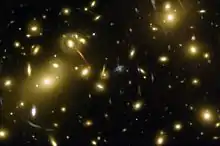Abell 2218
Abell 2218 is a cluster of galaxies about 2 billion light-years away in the constellation Draco.
| Abell 2218 | |
|---|---|
 | |
| Observation data (Epoch J2000) | |
| Constellation(s) | Draco |
| Right ascension | 16h 35m 54s[1] |
| Declination | +66° 13′ 00″[1] |
| Number of galaxies | ~10,000 |
| Richness class | 4[2] |
| Bautz–Morgan classification | II [2] |
| Redshift | 0.17560[1] |
| Distance (co-moving) | 719 Mpc (2,345 Mly) h−1 0.705 [1] |
| X-ray flux | (7.50 ± 9.1%)×10−12 erg s−1 cm−2 (0.1–2.4 keV) [1] |
Acting as a powerful lens, it magnifies and distorts all galaxies lying behind the cluster core into long arcs. The lensed galaxies are all stretched along the cluster's center and some of them are multiply imaged. Those multiple images usually appear as a pair of images with a third — generally fainter — counter image, as is the case for the very distant object. The lensed galaxies are particularly numerous, as we are looking in between two mass clumps, in a saddle region where the magnification is quite large.
Gravitational lensing
Abell 2218 was used as a gravitational lens to discover the most distant known object in the universe as of 2004. The object, a galaxy some 13 billion years old, is seen from Earth as it would have been just 750 million years after the Big Bang.[3]
The color of the lensed galaxies is a function of their distances and types. The orange arc is an elliptical galaxy at moderate redshift (z=0.7). The blue arcs are star-forming galaxies at intermediate redshift (z=1–2.5). There is a pair of images in the lower part of the picture of the newly discovered star-forming galaxy at about redshift 7.[4]
Dark matter
Clusters of galaxies such as Abell 2218 have also been used to infer both the amount[5][6] and distribution[7][8][9] of Dark matter.
See also
References
- "NASA/IPAC Extragalactic Database". Results for Abell 2218. Retrieved 2006-09-18.
- Abell, George O.; Corwin, Harold G., Jr.; Olowin, Ronald P. (May 1989). "A catalog of rich clusters of galaxies". Astrophysical Journal Supplement Series. 70 (May 1989): 1–138. Bibcode:1989ApJS...70....1A. doi:10.1086/191333. ISSN 0067-0049.
- NBC News: "Galaxy ranks as most distant object in cosmos"
- Kneib, Jean-Paul; Ellis, Richard S.; Santos, Michael R.; Richard, Johan (2004). "A Probable z~7 Galaxy Strongly Lensed by the Rich Cluster A2218: Exploring the Dark Ages". The Astrophysical Journal. 607: 697–703. arXiv:astro-ph/0402319. doi:10.1086/386281.
- Kneib, Jean-Paul (1995). "Dynamics of Abell 2218 from optical and near-IR imagery of arc(let)s and the Rosat/HRI X-ray map". Astronomy and Astrophysics. 303: 27–40. arXiv:astro-ph/9504038. Bibcode:1995A&A...303...27K.
- Squires, G.; Kaiser, N.; Babul, A.; Fahlman, G.; Woods, D.; Neumann, D.; Böhringer, H. (1996). "The dark matter, gas, and galaxy distributions in Abell 2218: A weak gravitational lensing and X-ray analysis". The Astrophysical Journal. 461: 572–586. arXiv:astro-ph/9507008. Bibcode:1996ApJ...461..572S. doi:10.1086/177085.
- Abdelsalam, Hanadi M.; Saha, Prasenjit; Williams, Liliya L. R. (1998). "Non-parametric reconstruction of Abell 2218 from combined weak and strong lensing". The Astronomical Journal. 116 (4): 1541–1552. arXiv:astro-ph/9806244. Bibcode:1998AJ....116.1541A. doi:10.1086/300546.
- Shan, Huanyuan; Qin, Bo; Fort, Bernard; Tao, Charling; Wu, Xiang-Ping; Zhao, Hongsheng (2010). "Offset between dark matter and ordinary matter: evidence from a sample of 38 lensing clusters of galaxies". Monthly Notices of the Royal Astronomical Society. 406 (2): 1134–1139. arXiv:1004.1475. Bibcode:2010MNRAS.406.1134S. doi:10.1111/j.1365-2966.2010.16739.x.
- Lorenz, Suzanne; Peterson, J. R. (2013). "New Techniques in Dark Matter Mapping". American Astronomical Society. 222 (id.103.02): 103.02. Bibcode:2013AAS...22210302L.
External links
| Wikimedia Commons has media related to Abell 2218. |
- Release about Abell 2218 at ESA/Hubble
- Astronomy Picture of the Day - Abell 2218: A Galaxy Cluster Lens - 2010 June 20
